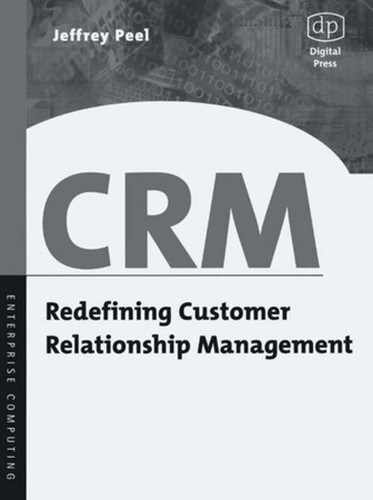
130 8.7 The customer service segment
8.6
8.7
Marketing CRM systems
Determining where a marketing system begins and an analytic system ends
is difficult. As mentioned, e.Piphany offers a strong solution that enables
powerful customer profiling and analytics to generate outbound marketing
opportunities. So is this an analytical solution or a marketing one? Over time,
this distinction will get increasingly difficult, not only for marketing but for
other types of CRM software as well. Increasingly complex heuristics and rou-
tines will take over complex manual operations.
That said, it is clear that the advent of CRM brought a number of inter-
esting new vendors onto the scene whose primary focus is on identifying and
attracting potential customers and better serving existing customers. Broadly
speaking, these vendors' offerings can be classified into campaign manage-
ment solutions and marketing resource management systems.
Campaign management systems are those that enable a company to archi-
tect and deliver marketing and sales campaigns to prospective customers.
While vendors such as Responsys and Annuncio allow companies to craft
e-marketing campaigns, other vendors such as DoubleClick and Engage offer
Web-served mass-marketing tools.
By contrast, marketing management systems are an emerging set of
systems that enables large companies to manage internal marketing commu-
nications, manage marketing processes, and, increasingly, conduct strategic
planning. Gartner refers to this segment as the marketing resource manage-
ment (MRM) segment of the CRM market. It remains to be seen who will
become dominant in the MRM market, but it is almost certainly going to
become an increasingly important part of the CRM market and one that the
suite vendors have paid insufficient attention to, to date.
The customer service segment
One of the most heavily invested in yet underappreciated areas of interaction
with the customer is customer service. This silo within the organization is
most often seen as a cost center rather than a potential profit center, and con-
sequently most of the software installed to meet these business processes tend
to focus on cost reduction and productivity improvements.
Customer service applications tend to fall into three distinct categories:
telephony systems such as ACDs, self-service Web applications, and e-channel
response management systems (ERMS). It is important to note that vendors

8.7 The customer service segment 131
in each of these categories have been actively trying (to a large extent unsuc-
cessfully) to blur the lines between these categories. The relative lack of success
derives from the fact that very different skills and underlying algorithms are
required to make successful solutions in each category.
Take, for example, the telephony sector. The goal of technologies in this
area is to handle synchronous (or real-time) communications between cus-
tomers and service organizations and route them through the system as
quickly and efficiently as possible. Because the subject of the call is not known
ahead of time, the solutions are focused on quickly assessing information and
using it to distribute the inbound call to the correct agent. Nortel Networks,
Genesys, and Avaya are three vendors in the telephony space that handle the
telephony infrastructure well. Ironically, all three vendors have made forays
into other areas in an attempt to cover other customer service channels as well.
Nortel finally gave up the attempt when it elected to sell its investment to
Amdocs. Genesys and Avaya also, in the context of providing universal queu-
ing capabilities to their product, attempted to extend their telephony-based
solutions into the Web and ERMS arena. These systems are both extremely
simple and vastly inferior to the more robust ERMS products available.
Similarly, most ERMS vendors offer some form of self-service capability.
Banter, for example, relies on the same underlying engine to handle both types
of e-service. Since escalation can occur directly from the self-service channel to
the ERMS, this approach has a great deal of appeal. Upon closer examination,
however, one usually finds that vendors are strong in only one of these areas.
Some of the most advanced self-service vendors, such as Autonomy or Ask
Jeeves, rely on Bayesian or other advanced technologies to enable them to
make correlations between Web content materials. However, such algorithms
are inappropriate in the ERMS segment, and vendors utilizing such cate-
gorization components, consequently, have a relatively weak and inflexible
product.
Within ERMS, the best known names are Kana, eGain, and Firepond
(which acquired the Brightware suite). Kana Response was one of the first
ERMS products available, and it maintains the dominant market share. In
general, these ERMS products were first architected for the Web-based econ-
omy~the dot-corns. While each has taken significant steps to address such
issues as multilingual capability, running multiple business units on a single
system without each sharing the entirety of information is tricky to say the
least. In addition, most of these ERMS vendors rely on manual composition
of rules. A best-of-breed player in this space is U.K.-based Amacis, which
uses IBM's powerful text analyzer (a WebSphere business component) for
I Chapter 8
..................Content has been hidden....................
You can't read the all page of ebook, please click here login for view all page.
